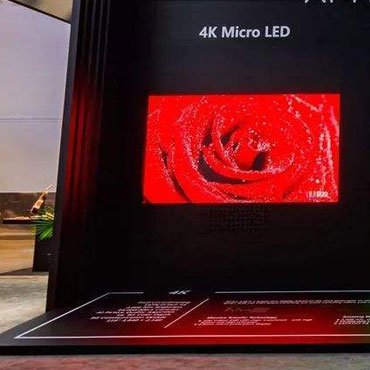I believe that many people have the feeling that using a large display to watch a movie or video can bring a more stunning visual experience, and a larger screen means that it can display more details and convey more content and information. Many display manufacturers have also noticed the large display brings people the feeling, so now the screen size has been from the initial 45 inches, 55 inches, to now 85 inches, 110 inches. If you want to experience a larger and wider display, then we need to use splicing display solutions.Currently, the mainstream splicing display solutions, mainly LED wall and video wall two. This article will be in-depth on the difference between LED wall vs video wall to do a detailed comparison, I believe that after you read it, you will definitely gain something.
About LED Wall
LED wall is composed of multiple energy efficient LED panels, also called LED video wall or LED panel wall. LED walls on the market are mainly based on COB (chip on board) and SMD (surface mount device) packaging technology. The difference between the two encapsulation technologies is that SMD LED can not do less than 1mm pitch, that is to say, when the LED panel on the LED lamp bead pitch is greater than 1mm, usually use SMD LED, if you choose COB LED price is several times more expensive, only when the LED lamp bead is less than 1mm, then only choose COB LED.

About video wall
From the search results given by Google, video wall usually refers to LCD video wall, which obviously belongs to a different technology and application than LED video wall. In terms of timeline, it appeared much earlier than LED wall. In the early stages of development, due to the LCD panel is small, usually need 4 or more LCD screens spliced together, LCD performance limitations of the video wall can not be spliced into too large a size. Therefore, before the emergence of LED wall, LCD video wall is just a transitional program for the display of large screens in the early stage.

LED wall vs Video Wall: Which is better?
In the next section, we will do a detailed comparison of the two different types of video walls and finally give a summary of which one is better.

Seamless viewing
Due to the technical limitations of the video wall, it is not yet possible to achieve a completely seamless splicing effect, which leads to the video wall when playing video, the picture will appear cut. And unlike the LED video wall can achieve completely seamless splicing effect.
This is mainly because the liquid crystal must be cut and wrapped in a specific container, when the two LCD monitors together, the equivalent of two separate containers side by side, the border can not be eliminated. LED video walls, on the other hand, have identical sizes and shapes of each LED module, so they can be spliced together in a completely seamless manner.
Display brightness
It is an indisputable fact that LCD video walls cannot achieve such high brightness as LED video walls. This is mainly because the LCD screen backlight display principle and optical structure limits the maximum display brightness of the LCD video wall. We are generally accustomed to the use of nits to indicate the brightness.
The highest display brightness of the video wall on the market can only reach 500 nits, perhaps some high-end LCD video can reach 800 nits, but with the display brightness is generally more than 1500 nits compared to the LED wall, there is still a large gap.
As the video wall display brightness is low, means that if in the strong light (such as sunlight), its visibility will become very poor. The video wall composed of LED displays is mostly not bothered by this problem, so if we look closely we will find that all large outdoor screens, are composed of LED displays.
Resolution and color mode
The vast majority of video walls on the market today are using 2K or 4K resolution, which is the same as the LED video wall display. Compared to LED video walls, LCD video walls usually provide more color configuration options, and can even automatically switch to different color modes according to the use of the environment. While LED video walls can only adjust the brightness and cannot automatically switch to different color modes.
Aesthetics
The thickness of the video wall varies depending on the area to be spliced. When we will be 2 or 4 video walls spliced together, the thickness of more than 110 millimeters, whether it is close up or from a distance its effect is somewhat unsatisfactory. While the LED video wall is also composed of a single LED panel, but whether it is up close or from a distance is a complete whole, plus 5 cm outside the border wrapping, aesthetics is very high, will not have any negative impact on the viewing.
Size
Still trapped in the physical nature of the LCD, LCD video wall usually can not be spliced into a particularly large size. On the one hand, too many LCD screens at the same time, the need for very high voltage, and secondly, running multiple screens at the same time the heat generated by a lot of wires is difficult to withstand. LED video wall is completely different.
Theoretically, as long as there is enough money and space, LED video wall can be extended indefinitely. In practice, we can also see, for example, up to hundreds of thousands of square meters of the Beijing Olympic Games and the Beijing Winter Olympics, as well as in the New York in Times Square, a variety of large-scale 3D billboard advertising examples, are living examples.
It is worth mentioning that, although the large size of the video wall is occupied by the LED display, but on the contrary, the LCD screen in the production of small-sized video wall has a natural advantage, so in the field of small displays LCD screen still occupies a dominant position.
Installation and maintenance
Have to admit, LED wall in the installation and maintenance are much simpler than LCD video. Although it is said that the LED wall and video wall, in the building before the need to make the appropriate load-bearing structure, otherwise such a heavy object is difficult to hang on the wall for long-term use. However, the LED video wall generally only need 2 people to operate in concert, you can complete the entire installation process.
And LCD video wall is obviously much more difficult, at least 3 people need to work together. In addition, if the LCD video wall fails, you will have to dismantle the entire screen, an operation that will render the other screens unusable for the next period of time. However, with an LED video wall, you usually only need to remove and replace the faulty part, and the whole process usually takes no more than half an hour.
Price
In the short term, LCD video walls are less expensive than LED video walls, but when evaluated in terms of longevity, maintenance costs, etc., LED video walls cost significantly less than LCD video walls.
Summarize
After reading the comparison of LED wall and video wall, I believe you have left a deep impression on both. Although the LCD video wall has been around for a long time, but no matter from the picture quality, energy loss, performance, or installation and maintenance, LED video wall is always a big step higher than the LCD video wall. If you want to put together a pleasingly large display, then an LED wall is clearly the way to go.




